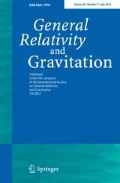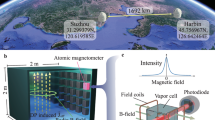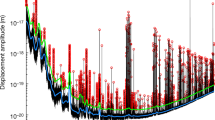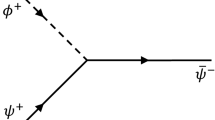Abstract
We study the environmental dependence of ultralight scalar dark matter (DM) with linear interactions to the standard model particles. The solution to the DM field turns out to be a sum of the cosmic harmonic oscillation term and the local exponential fluctuation term. The amplitude of the first term depends on the local DM density and the mass of the DM field. The second term is induced by the local distribution of matter, such as the Earth. And it depends not only on the mass of the Earth, but also the density of the Earth. Then, we compute the phase shift induced by the DM field in atom interferometers (AIs), through solving the trajectories of atoms. Especially, the AI signal for the violation of weak equivalence principle (WEP) caused by the DM field is calculated. Depending on the values of the DM coupling parameters, contributions to the WEP violation from the first and second terms of the DM field can be either comparable or one larger than the other. Finally, we give some constraints to DM coupling parameters using results from the terrestrial atomic WEP tests.




Similar content being viewed by others
Data availability
Data sharing not applicable to this article as no datasets were generated or analysed during the current study.
Notes
To see this, it is easier to use a different DM coupling parameter notation \(\{\Lambda _{\gamma },\Lambda _{g},\Lambda _{i}\}\). This notation is related to ours by \(d_e=M_P/(4\pi \Lambda _{\gamma })\), \(d_g=M_P/(4\pi \Lambda _{g})\), and \(d_{m_i}=M_P/(4\pi \Lambda _{i})\). These \(\Lambda _{\gamma , g,i}\) parameters have dimensions of energy, which can be regarded as UV cutoffs of some underlying theory. According to the spirit of effective field theory, terms, like \(\sum _{n=2}^{\infty } C^F_{n} (\Phi /\Lambda _{\gamma })^n (F_{\mu \nu })^2\), \(\sum _{n=2}^{\infty } C^g_{n} (\Phi /\Lambda _{g})^n (F_{\mu \nu }^{A})^{2}\), and \(\sum _{n=2}^{\infty } C^i_{n} (\Phi /\Lambda _{i})^n m_i {\bar{\psi }}_i\psi _i\), will be generated. In the end, these terms produce the higher order \(\varphi \)-dependence in the Earth’s mass (16).
Note that the case here is different from the issue of naturalness. There, corrections to the mass of scalar field are generated by one-loop Feynman diagrams, which depend on some (arbitrary) UV cutoff scale. On the other hand, our correction in Eq. (26) comes from the \(\varphi ^2\)-dependence in the Earth’s mass as discussed above. We will omit the issue of naturalness in this paper, and readers can refer to the papers [10, 19] for further discussion.
References
Gorenstein, P., Tucker, W.: Astronomical signatures of dark matter. Adv. High Energy Phys. 2014, 1 (2014). https://doi.org/10.1155/2014/878203
Mondino, C., Taki, A.-M., Van Tilburg, K., Weiner, N.: First results on dark matter substructure from astrometric weak lensing. Phys. Rev. Lett. 125, 111101 (2020). https://doi.org/10.1103/PhysRevLett.125.111101
Abdullah, M.H., Klypin, A., Wilson, G.: Cosmological constraints on \({\Omega }_{m}\) m and \(\sigma _{8}\) from cluster abundances using the GalWCat19 optical-spectroscopic SDSS catalog. Astrophys. J. 901(2), 90 (2020). https://doi.org/10.3847/1538-4357/aba619
Refregier, A.: Weak gravitational lensing by large-scale structure. Annu. Rev. Astron. Astrophys. 41(1), 645 (2003). https://doi.org/10.1146/annurev.astro.41.111302.102207
Allen, S.W., Schmidt, R.W., Fabian, A.C., Ebeling, H.: Cosmological constraints from the local X-ray luminosity function of the most X-ray-luminous galaxy clusters. Mon. Not. R. Astron. Soc. 342(1), 287 (2003). https://doi.org/10.1046/j.1365-8711.2003.06550.x
Rubin, V.C., Ford, W.K., Jr., Thonnard, N.: Rotational properties of 21-SC galaxies with a large range of luminosities and radii, from NGC 4605 (R = 4 kpc) to UGC 2885 (R = 122 kpc). Astrophys. J. 238(2), 471 (1980). https://doi.org/10.1086/158003
Akerib, D.S., et al.: Results from a search for dark matter in the complete LUX exposure. Phys. Rev. Lett. 118, 021303 (2017). https://doi.org/10.1103/PhysRevLett.118.021303
Fu, C., et al.: Spin-dependent weakly-interacting-massive-particle-nucleon cross section limits from first data of PandaX-II experiment. Phys. Rev. Lett. 118, 071301 (2017). https://doi.org/10.1103/PhysRevLett.118.071301
Aprile, E., et al.: First results on the scalar WIMP-pion coupling, using the XENON1T experiment. Phys. Rev. Lett. 122, 071301 (2019). https://doi.org/10.1103/PhysRevLett.122.071301
Arvanitaki, A., Huang, J., Van Tilburg, K.: Searching for Dilaton dark matter with atomic clocks. Phys. Rev. D 91, 015015 (2015). https://doi.org/10.1103/PhysRevD.91.015015
Roberts, B.M., et al.: Search for domain wall dark matter with atomic clocks on board global positioning system satellites. Nat. Commun. 8(1), 1195 (2017). https://doi.org/10.1038/s41467-017-01440-4
Van Tilburg, K., Leefer, N., Bougas, L., Budker, D.: Search for ultralight scalar dark matter with atomic spectroscopy. Phys. Rev. Lett. 115(1), 011802 (2015). https://doi.org/10.1103/PhysRevLett.115.011802
Leefer, N., Gerhardus, A., Budker, D., Flambaum, V.V., Stadnik, Y.V.: Search for the effect of massive bodies on atomic spectra and constraints on Yukawa-type interactions of scalar particles. Phys. Rev. Lett. 117(27), 271601 (2016). https://doi.org/10.1103/PhysRevLett.117.271601
Graham, P.W., Kaplan, D.E., Mardon, J., Rajendran, S., Terrano, W.A.: Dark matter direct detection with accelerometers. Phys. Rev. D 93, 075029 (2016). https://doi.org/10.1103/PhysRevD.93.075029
Obata, I., Fujita, T., Michimura, Y.: Optical ring cavity search for axion dark matter. Phys. Rev. Lett. 121(16), 161301 (2018). https://doi.org/10.1103/PhysRevLett.121.161301
Geraci, A.A., Bradley, C., Gao, D.F., Weinstein, J., Derevianko, A.: Searching for ultralight dark matter with optical cavities. Phys. Rev. Lett. 123, 031304 (2019). https://doi.org/10.1103/PhysRevLett.123.031304
Stadnik, Y.V., Flambaum, V.V.: Searching for dark matter and variation of fundamental constants with laser and maser interferometry. Phys. Rev. Lett. 114(16), 161301 (2015). https://doi.org/10.1103/PhysRevLett.114.161301
Stadnik, Y.V., Flambaum, V.V.: Enhanced effects of variation of the fundamental constants in laser interferometers and application to dark-matter detection. Phys. Rev. A 93(6), 063630 (2016). https://doi.org/10.1103/PhysRevA.93.063630
Grote, H., Stadnik, Y.V.: Novel signatures of dark matter in laser-interferometric gravitational-wave detectors. Phys. Rev. Res. 1(3), 033187 (2019). https://doi.org/10.1103/PhysRevResearch.1.033187
Cronin, A.D., Schmiedmayer, J., Pritchard, D.E.: Optics and interferometry with atoms and molecules. Rev. Mod. Phys. 81, 1051 (2009). https://doi.org/10.1103/RevModPhys.81.1051
Morel, L., Yao, Z., Cladé, P., Guellati-Khélifa, S.: Determination of the fine-structure constant with an accuracy of 81 parts per trillion. Nature 588(7836), 61 (2020). https://doi.org/10.1038/s41586-020-2964-7
Zhou, L., et al.: Joint mass-and-energy test of the equivalence principle at the \({10}^{-10}\) level using atoms with specified mass and internal energy. Phys. Rev. A 104, 022822 (2021). https://doi.org/10.1103/PhysRevA.104.022822. arXiv:1904.07096
Asenbaum, P., Overstreet, C., Kim, M., Curti, J., Kasevich, M.A.: Atom-interferometric test of the equivalence principle at the \({10}^{-12}\) level. Phys. Rev. Lett. 125, 191101 (2020). https://doi.org/10.1103/PhysRevLett.125.191101
Geraci, A.A., Derevianko, A.: Sensitivity of atom interferometry to ultralight scalar field dark matter. Phys. Rev. Lett. 117, 261301 (2016). https://doi.org/10.1103/PhysRevLett.117.261301
Arvanitaki, A., Graham, P.W., Hogan, J.M., Rajendran, S., Van Tilburg, K.: Search for light scalar dark matter with atomic gravitational wave detectors. Phys. Rev. D 97, 075020 (2018). https://doi.org/10.1103/PhysRevD.97.075020
Damour, T., Donoghue, J.F.: Equivalence principle violations and couplings of a light dilaton. Phys. Rev. D 82, 084033 (2010). https://doi.org/10.1103/PhysRevD.82.084033
Damour, T., Donoghue, J.F.: Phenomenology of the equivalence principle with light scalars. Class. Quantum Grav. 27(20), 202001 (2010). https://doi.org/10.1088/0264-9381/27/20/202001
Damour, T., Esposito-Farèse, G.: Tensor-multi-scalar theories of gravitation. Class. Quantum Grav. 9(9), 2093 (1992). https://doi.org/10.1088/0264-9381/9/9/015
Hees, A., Minazzoli, O., Savalle, E., Stadnik, Y.V., Wolf, P.: Violation of the equivalence principle from light scalar dark matter. Phys. Rev. D 98, 064051 (2018). https://doi.org/10.1103/PhysRevD.98.064051
Morgan, J.W., Anders, E.: Chemical-composition of Earth, Venus, and Mercury. Proc. Natl. Acad. Sci. USA 77(12), 6973 (1980). https://doi.org/10.1073/pnas.77.12.6973
Freese, K., Lisanti, M., Savage, C.: Colloquium: Annual modulation of dark matter. Rev. Mod. Phys. 85(4), 1561 (2013). https://doi.org/10.1103/RevModPhys.85.1561
Kasevich, M., Chu, S.: Measurement of the gravitational acceleration of an atom with a light-pulse atom interferometer. Appl. Phys. B 54(5), 321 (1992). https://doi.org/10.1007/BF00325375
Dimopoulos, S., Graham, P.W., Hogan, J.M., Kasevich, M.A.: General relativistic effects in atom interferometry. Phys. Rev. D 78, 042003 (2008). https://doi.org/10.1103/PhysRevD.78.042003
Flambaum, V.V., Tedesco, A.F.: Dependence of nuclear magnetic moments on quark masses and limits on temporal variation of fundamental constants from atomic clock experiments. Phys. Rev. C 73, 055501 (2006). https://doi.org/10.1103/PhysRevC.73.055501
Bergé, J., Brax, P., Métris, G., Pernot-Borràs, M., Touboul, P., Uzan, J.-P.: MICROSCOPE mission: first constraints on the violation of the weak equivalence principle by a light scalar Dilaton. Phys. Rev. Lett. 120, 141101 (2018). https://doi.org/10.1103/PhysRevLett.120.141101
Touboul, P., et al.: MICROSCOPE mission: first results of a space test of the equivalence principle. Phys. Rev. Lett. 119, 231101 (2017). https://doi.org/10.1103/PhysRevLett.119.231101
Hsu, H.P.: Schaum’s Outline of Theory and Problems of Probability, Random Variables, and Random Processes. McGraw-Hill, New York (1997)
Acknowledgements
This work was supported by the National Key Research and Development Program of China under Grant No. 2016YFA0302002, and the Strategic Priority Research Program of the Chinese Academy of Sciences under Grant No. XDB21010100. We thank the referees for their helpful comments and suggestions that significantly polish this work.
Author information
Authors and Affiliations
Corresponding author
Additional information
Publisher's Note
Springer Nature remains neutral with regard to jurisdictional claims in published maps and institutional affiliations.
Appendices
Calculation of velocity and position of atoms
Solving Eq. (36) is as follows. We first integrate on both sides to get the velocity,
Here, \(z^{(0)}(t)\) denotes the unperturbed atomic trajectory, which is nothing but the freefall trajectory
where \(t_i\) is the initial time, \(z_i^{(0)}\) and \(v_i^{(0)}\) are respectively the initial position and velocity for each segment of the freefall trajectory.
To finish the integration in Eq. (51), we do the following approximation,
Then we can get the result
where
and
It is clear that \({\dot{z}}_{\mathrm{exp}}\) and \({\dot{z}}_{\mathrm{bg}}\) denote effects from the exponential term and the oscillation background term of the DM field, respectively.
For later use, we give the following velocities. At the time of applying the \(\pi \)-pulse, the velocity for atoms in the lower arm is \({\dot{z}}_{1l}\equiv {\dot{z}}(t)\vert _{t=T}\) with \(t_i=0\) and \({\dot{z}}(t_{i})=v_L\), while the velocity for atoms in the upper arm is \({\dot{z}}_{1u}\equiv {\dot{z}}(t)\vert _{t=T}\) with \(t_i=0\) and \({\dot{z}}(t_{i})=v_L+v_R(\varphi )\). At the time of applying the second \(\frac{\pi }{2}\)-pulse, \({\dot{z}}_{2l}\equiv {\dot{z}}(t)\vert _{t=2T}\) with \(t_i=T\) and \({\dot{z}}(t_{i})={\dot{z}}_{1l}+v_R(\varphi )\), while \({\dot{z}}_{2u}\equiv {\dot{z}}(t)\vert _{t=2T}\) with \(t_i=T\) and \({\dot{z}}(t_{i})={\dot{z}}_{1u}-v_R(\varphi )\).
Next, we do the time integration on Eq. (54) to get the solution for the trajectory
For later use, we give the following positions. At the time of applying the \(\pi \)-pulse, the position for atoms in the lower arm is \(z_{1l}\equiv z(t)\vert _{t=T}\) with \(t_{i}=0\), \(z(t_{i})=0\) and \({\dot{z}}(t_{i})=v_L\), while the position for atoms in the upper arm is \(z_{1u}\equiv z(t)\vert _{t=T}\) with \(t_{i}=0\), \(z(t_{i})=0\) and \({\dot{z}}(t_{i})=v_L+v_R(\varphi )\). At the time of applying the second \(\frac{\pi }{2}\)-pulse, \(z_{2l}\equiv z(t)\vert _{t=2T}\) with \(t_{i}=T\), \(z(t_{i})=z_{1l}\) and \({\dot{z}}(t_{i})={\dot{z}}_{1l}+v_R(\varphi )\), while \(z_{2u}\equiv z(t)\vert _{t=2T}\) with \(t_{i}=T\), \(z(t_{i})=z_{1u}\) and \({\dot{z}}(t_{i})={\dot{z}}_{1u}-v_R(\varphi )\).
Calculation of the DM-induced phase shift in AI experiments
The total phase shift can be written as a sum of three components [33], the propagation phase shift, the laser phase shift, and the separation phase shift,
For each segment of the atomic trajectory, the atom accumulates a propagation phase
where \(t_f\) is the final time for each segment, and L is the Lagrangian (31). The propagation phase shift \(\Delta \phi _{prop}\) is the difference in the propagation phase between the two arms,
The laser phase shift comes from the interaction of laser pulses with atoms. At each interaction point, the laser field transfers its phase to the atom. Then, \(\Delta \phi _{laser}\) is the difference in the accumulated laser phase between the upper and lower arms
where \(z_i\) is the initial position of atoms at the time of applying the first \(\frac{\pi }{2}\)-pulse.
Since the two arms do not exactly intersect at the final laser pulse, then the separation phase shift \(\Delta \phi _{sep}\) appears.
With Eqs. (54) and (57), we can calculate \(\phi _{prop}\) along each segment of the lower and upper arms, and thus compute \(\Delta \phi _{prop}\). Similarly, \(\Delta \phi _{laser}\) and \(\Delta \phi _{sep}\) can also be computed. Summing them together, one can get the final result for the DM-induced phase shift. We find that \(\Delta \phi \) consists of a static component \(\Delta \phi _{\delta \varphi }\), an oscillatory component \(\Delta \phi _{bg}\), and the well-known term \(-g_{0}T^2k_{\text {eff}}\),
The first term is the known phase shift for atoms in freefall, where \({\mathbf{k }}_{\mathrm{eff}}\) has been taken to be parallel to \({\mathbf{g }}_0\). The \(\delta \varphi \)-contribution to \(\Delta \phi \) is given by
The \(\varphi _{bg}\)-contribution to \(\Delta \phi \) is given by
Rights and permissions
About this article
Cite this article
Zhao, W., Gao, D., Wang, J. et al. Investigating the environmental dependence of ultralight scalar dark matter with atom interferometers. Gen Relativ Gravit 54, 41 (2022). https://doi.org/10.1007/s10714-022-02925-4
Received:
Accepted:
Published:
DOI: https://doi.org/10.1007/s10714-022-02925-4




